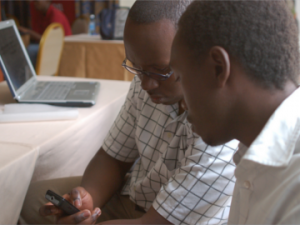
Broadening access to financial technology is a major challenge for organisations that are looking to grow in emerging markets. Finovate Europe is a launching pad for some of the most exciting fintech trends on the horizon, but how will they impact on groups that have typically been shut out?
To find out, we headed to Harnessing Innovation for Financial Inclusion, run by the World Bank. Here are the three most exciting new ways that the companies we met are using fintech to boost inclusion.
1. Helping newbies get a credit score
The problem: One of the biggest problems for migrants and others without a publicly available financial history is getting a decent credit score. You may never have messed up, and you might well be a budgeting ninja, but your “thin file” means you can’t prove a thing when you go to open a bank account, take out a credit card or apply for a loan.
The solution: The team at London-based Aire come from a range of different backgrounds but, they say, all have one thing in common: they’ve all been denied credit because of the thin file problem. To get around it, they’ve built a brand new platform that works with users to do a free, deep assessment based on the information and behavioural data that they do have access to, to help them prove that they’re not a liability, and persuade banks and creditors to give them a chance.
2. Helping migrants send money home
The problem: Going overseas to make enough money to support a family back home is the stark reality for much of the world’s population, and billions of dollars are transferred around the globe in remittances every day. In some areas, such as the Pacific Islands, up to 40% of income is made up by these remittances, but up to 20% of that can be swallowed up in fees, meaning that some of the lowest paid workers are losing a significant chunk of that income, just by moving it around.
The solution: A new wave of remittance companies, led by companies like Azimo and KickEx, are making strides in fixing this massive issue. Their services allow people to transfer their money around the world using a similar service to Western Union, but charging comparatively tiny fees – typically between 1% and 2%. You need a bank account to send the money, which is usually a given in the richer countries that workers migrate to, but it can be picked up in cash at various outlets, if preferred. As Azimo’s Michael Kent told a roomful of investors and CEOs:“This service is not for you. It’s for the people that will clean up when you leave today. It’s for the people who drove you here in your Uber taxi.”
3. Mobile payments for non-smartphone users
The problem: Smartphone usage is on the rise – but simpler “feature” phones will still dominate the global market by 2018, especially in the world’s poorest countries. Mobile payments and wallets are often pitched as a great alternative for the world’s unbanked, but for many of the options out there, if you don’t have a smartphone, you’re shut out from these, too.
The solution: Systems like Mobino, which transfer money instantaneously between accounts of any currency with no fees, do have a non-smartphone option, but their main aim is simplifying the way payments are made, not widening their access for new markets. Technology company Copsonic, on the other hand, is seeking to address this very issue. Compatible with all types of phone, it uses ultrasonic waves to make transfers between devices, works in extreme weather conditions and, excitingly, builds antennae that can be used to set up Small Public Payment Networks (SPPNs) with a working radius of 36km – meaning that working payment networks can be run in remote locations with little access to banks or even the internet. It’s free for users and merchants, and, according to the creators, cuts out 90% of transaction costs for banking partners.







